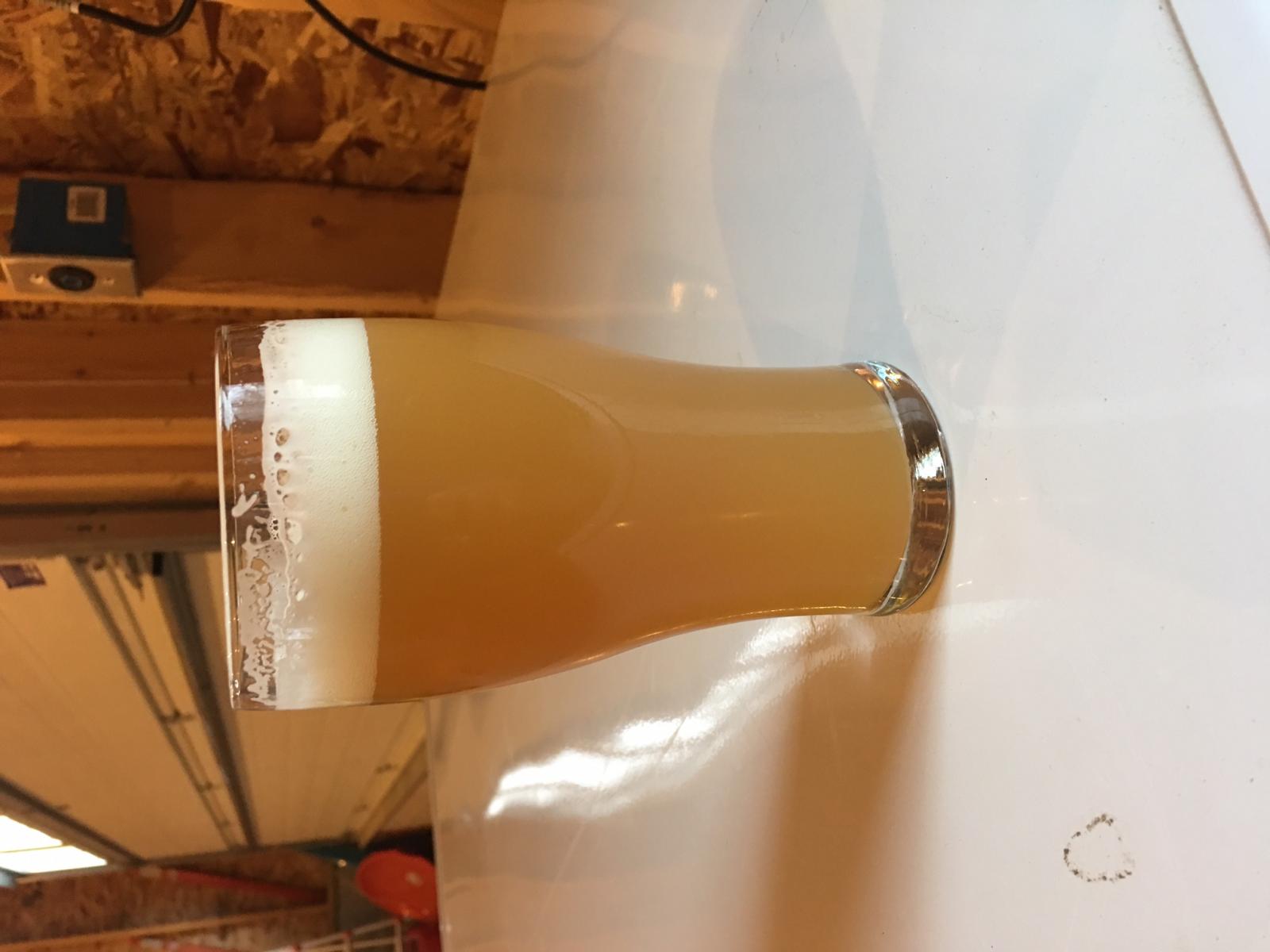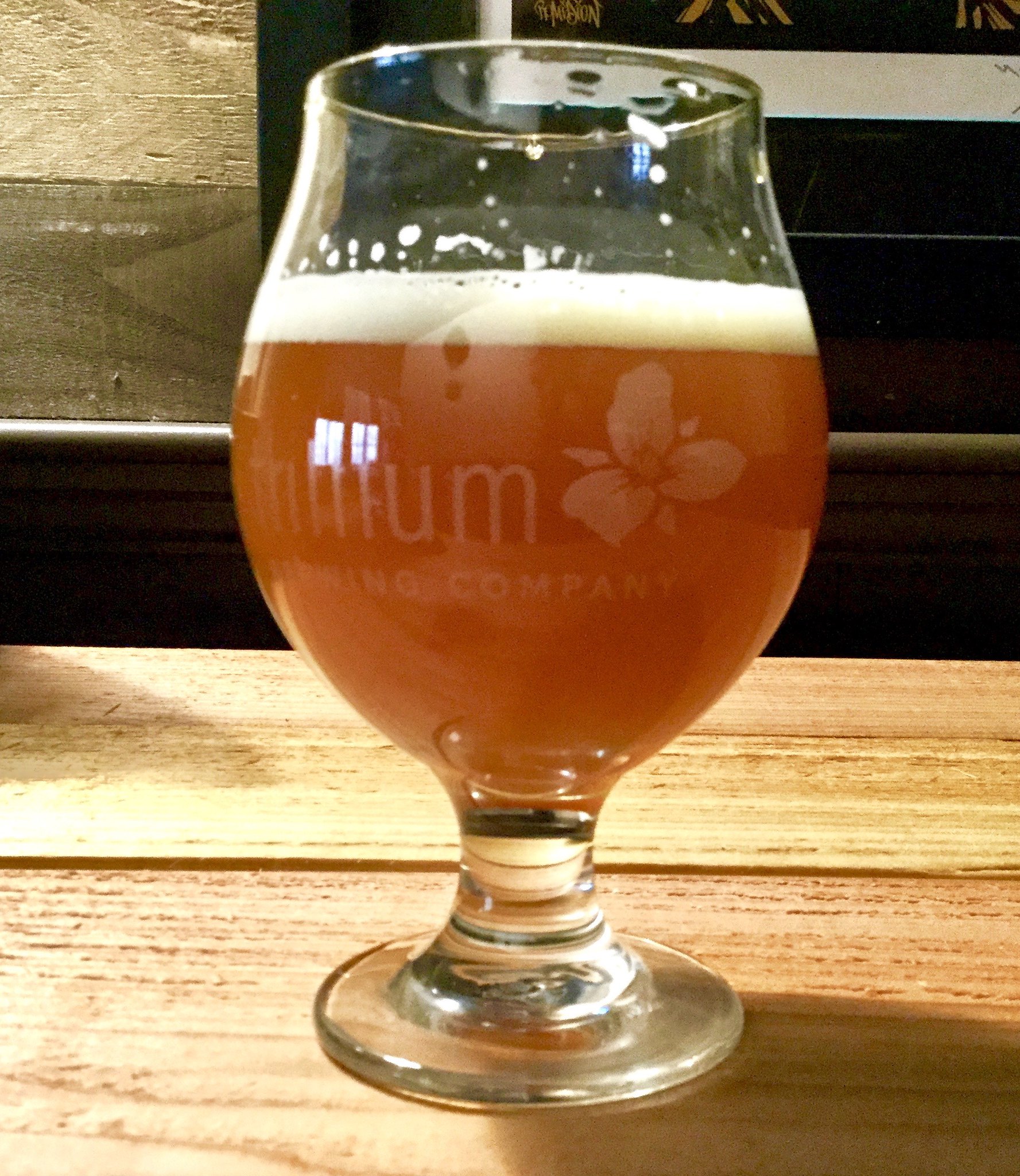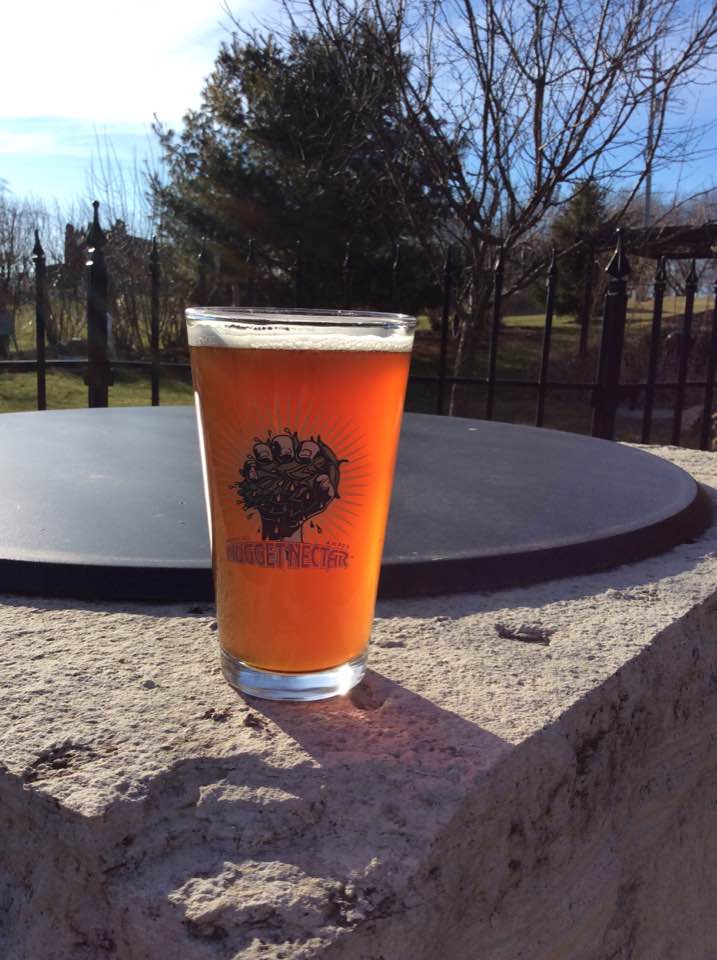Nice pic! Where's the unicorn?
In the glass!

Nice pic! Where's the unicorn?
I was worried that I mashed too low due to some issues I had with my controller, but this came out great! Next time think I'm going to use just a little crystal.

Should have run out there a ways and held up your glass so it looked like the rainbow was ending at your glass
No, because nothing is under pressure. When you open the fermentor to add the second dry hop, the sanitizer doesn't rush back from the second bottle into the first - it just sits there. The CO2 doesn't get sucked back into the fermentor until the temp drop causes the head space to contract.
A tiny bit of air might get into the fermentor when you open it to add the second dry hop, but I just pull out the stopper, dump in the hops, and put the stopper back in. I think the gas exchange is very minimal because it's neutral pressure.
















I'm interested to see if anyone has an opinion on why my latest beer turned out so hazy (and delicious!):

I ordered Northern Brewer's Grapefruit Pulpin' kit (http://www.northernbrewer.com/grapefruit-pulpin-all-grain-kit) during a sale last year (3 kits, $20 each) and kept the grain bill the same, so no adjuncts.
I did increase the amount of hops from 6 oz to 12 oz plus hop extract for bittering, but I've used over 1 lb of hops before and had clear beer. Water profile favored SO4 v. Cl (250:50) and mash pH was 4.35.
I used WY1272 and didn't dry hop until the yeast had flocc'd (6 days post pitch), however, I did add a dried grapefruit peel/vodka tincture to the fermentor at this time. I use stainless, so I don't know if a re-fermentation kicked off or not, but I kegged 3 days later and everything looked fine. The beer did appear hazy as it ran through the tubing though.
Any thoughts as to why I have so much haze? Maybe my beers know how much I like NE IPA and refuse to go back to the west coast style
I've been meaning to share a technique I've been using recently to cold crash with virtually no oxygen exposure. It doesn't require hooking up CO2, a second regulator, or any extra equipment other than $2 worth of drilled stoppers.
I think cold crashing this beer is important. Before I started cold crashing, I would get at least a week or two of harsh bite from suspended hop particles. Sometimes it never really went away. I would also have a bunch of sludge at the bottom of the keg when it kicked, which would mess up my beer lines, etc.
I also think avoiding oxygen exposure is very important to this style, and I'm just not OK with sucking a bunch of air into the headspace while cold crashing. Before I started doing this, I could actually see a thin dark layer of oxidized beer forming at the top of the fermentor while crashing.
So, here's what I came up with for storing some CO2 from fermentation, and feeding it back into the primary while cold crashing. I had seen some other threads on this talking about mylar balloons and all kinds of stuff, but I think this is a more elegant, sanitary approach.
Here's how it works: I start off with the blowoff tube (the yellowed one) in a normal jar or whatever. Once I am past any potential blowoff risk, but still actively fermenting, I put that hose into the top of the first jug, which starts off filled to the top with star san. The CO2 pressure pushes that star san through the jumper line into the second jug, which fills up and then just allows excess CO2 to bubble out into the atmosphere. The first jug is now full of CO2. This is what's pictured below.
When I start to cold crash, the headspace contracts, which sucks star san from the second jug back into the first, and CO2 from the first jug back into the fermentor. That fermentor is a thin-walled plastic Fermonster, and there's little enough negative pressure that it doesn't even buckle. At the end of the cold crash, the first jug is filled back up about 1/2 to 2/3 of the way.
When I'm done cold crashing, I just take the stopper out of the fermentor and hang a CO2 line in there, trickling CO2 to maintain positive pressure as the beer siphons out. There's no rush of air when I take the stopper out because there's no negative pressure. I siphon into a keg that has been filled with star san and purged with CO2, so the beer comes into no contact with oxygen.
I do all of my dry hopping loose in primary, but by cold crashing I get almost no trub or hop matter into the keg. When the keg kicks, the bottom is nearly clean.
The one thing that may be tricky is finding a double-drilled stopper. The guy at my LHBS has a drill bit in the back that does it, so he just gave me those two stoppers for $1 each. I think I've seen threads about people doing it themselves with a piece of copper pipe or something. I guess a normal drill bit doesn't work too well. The jugs are 1-gallon fermentors I had lying around.
Anyway, hope someone finds this helpful. This is the best balance I've found between (relative) simplicity and feeling like I'm doing the best I can do avoid O2 and improve my beer.

Fixed the pH typo, you were correct.
That was probably the 10th pour (day 5 in keg), as I sample 2-4 oz each day its in the keg, to monitor carbonation, aroma, etc. I don't believe its yeast/trub, as nothing settles out if you leave the glass in the fridge (and I transferred from a SS brewtech conical). Additionally, there aren't any hop particles floating around or off flavors that I can discern, so I think its just super haze.

I got into this strictly to brew NE IPAs
brewed my first batch about 3.5 weeks ago
next batch is going to be all grain BIAB! Stepping it up.
transferred to keg via Co2
I originally was going to bottle but realized O2 is the enemy of these beers so set up a 3 tap keg system. Did a closed transfer this time and all went well.



Ok...... I think I have gotten to the place where I can recommend an Amber Ale version of this..... I still may tweak the hops just a bit - but this is pretty damn good as brewed.
Beer - Big Muddy Red - NE style Amber Ale
Grain Bill to 1.060 OG:
63% 2 Row
14% Weyerman Munich
7% Flaked Oats
7% Wheat
3.5% Breiss Caramel 80
3.5% CaraMunich I (57L)
1.5% Aromatic
.5% Carafa II (For color into 12-13-14 SRM range.... could use Roast Barley too, or Midnight Wheat - it is just 1-2 ounces for color)
Hops:
60 min. 1 oz. Horizon (this is a great amber ale hop.... Nugget might be solid too)
10 min. 1oz. each Cascade and Centennial
Flameout 2 oz. Falconers Flight
Whirl pool/Hop Stand at under 170 degrees 2 oz. Falconers Flight
Dry hop at day three 2 oz. Falconers Flight
Mash @ 155 for 60 minutes
Yeast = 1272
Water:
Ca = 66
Mg = 2
Na = 13
Sulfate = 78
Chloride = 62
Bicarbonate = 72
Projected pH = 5.40
*I used 80% RO on this one. 20% of my high bicarbonate tap water...... not sure that that is "necessary" - but it is what I did on this batch.
Thoughts -
* I like the grain bill...... Maybe up the flaked??? Not sure if it is needed or would make a difference though.
* I like the yeast..... Second choice would be 1056 I think
* Water seemed good
*Beer is rich, creamy, full - nice spicy/fruity hops. Balanced. Super drinkable.
* What might I play around with...... Maybe a bit more Cascade/Centennial late or in flame out/whirlpool?? Maybe an ounce of Horizon late?? Falconers Flight Hop blend is a killer hop for Ambers. I think it is the ticket for whirlpool/ Dry hops. Horizon is a great hop in Ambers.
Falconers Flight (not the 7 C's....... just the Falconers Flight): http://labelpeelers.com/beer-making/hops/falconers-flight-hops/falconers-flight-hops-pellet-1-lb/
i fined in the primary with 1/2 tsp for a 4 gallon batch. the beer was around 36F when fined. i just did it last week, so both beers are still around. i noticed last night that the unfined version is getting pretty clear too, must be something about the brewing salts, yeast or hopping that allowed it to clear so fast, way faster than my NE IPAs.... I'll continue to monitor and see if there is a difference. i think i need to redo this with one of my NE IPAs...
Have you ever used quaker oats in your beers? Thats what i used in my version, the 1.2# can found in grocery stores
Have you ever used quaker oats in your beers? Thats what i used in my version, the 1.2# can found in grocery stores
^i always do quick oats; upwards of 18% with no problems - I even mill them. I get them in the bulk section of the grocery store for a great price
Had to brew it myself but I finally got to try one of these thanks to all the tips in this great thread. 3 weeks from brew-day. This was the first time I tried the dry hop method from the original post - worked awesome!
Malt bill=MO, munich, flaked wheat
Hops=Apollo (FWH), citra, mosaic, galaxy, amarillo
Yeast=OYL-057
OG=1.076
FG=1.020
Water (ppm)=152Ca, 134 So, 173 Cl
Would you perhaps share the full recipe??? This looks delish
Can this style beer still be made in all it's greatness, with the whole package of components from the juiciness, the haziness, the flavor, the aroma and so on and so forth... but instead of loose pellets for the biotransform hop and the subsequent post-ferm dry hop, all the hopping done in fine mesh bags?
Will the oils and hop particles still interact with the yeasties?
I'm having issues transferring beer in my SS brewtech bucket and sucking into hops into my keg with transferring due to the loose pellets finding it's way into the pickup tube
I currently have no means of cold crashing my 7.5 bucket (mini fridge not big enough to house it without modifying it significantly), and there's no room in the keezer (nor would it be easy to get it in and out of there without killing my back or sloshing everything that settles to the bottom haha
Anyway, thoughts on making these beers with bagged hops for bioferm hopping and postferm hopping?